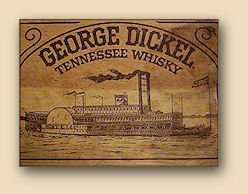American
Whiskey:
April
29,
2011
--
Tennessee
Whiskey
Country
The George A.
Dickel Distilling Company
We spent last night at the Best Western Celebration Inn in Shelbyville, about a half hour from the George Dickel Distillery at Cascade Hollow. And we awake this morning nearly an hour later than we’d planned, upset that the motel has missed a requested wakeup call. Fortunately, before John gets a chance to embarrass himself by calling the front desk, Linda remembers that we are now in the Central Time Zone – an hour earlier than our watches! Ten minutes later -- and right on schedule, of course -- the phone rings.
Today we are going to explore the entire (legal) Tennessee whiskey industry,
which consists of only three distillers located less than twenty miles from
one another (well, yes there is a fourth and fifth, Corsair and Collier &
McKeel, in Nashville, but we
visited those already on our way here). Our first stop is at the
George
A. Dickel distillery just outside the unincorporated village of
Normandy, near Tullahoma. Only a couple days ago this area was being
deluged with some of the heaviest rains they've ever had. Thunderstorms
and winds (the same storm system that devastated parts of nearby states)
took down trees and electric poles. But this morning is brilliantly sunny
and dry. Getting to the distillery site involves traveling along several
miles of lovely country back roads, set in the lush spring-green hills and
valleys. As we approach the distillery, we are again struck by its
setting, easily the most beautiful of any distillery we've ever visited.
The road winds through a tiny valley, and set against the hillsides on
both sides, the visitor center, the charcoal-making area, and, across the
road, the distillery itself are clean and attractive.
The origins of commercial whiskey distilling in Tennessee
go way back, and they are impressive, indeed. According to
Henry C. Crowgey, in his book
Kentucky Bourbon: The Early Years
of Whiskey-Making, Evan Shelby operated the East Tennessee Distillery
near what is now Bristol in Sullivan County as early as 1771. Kay
Baker Gaston, in an article she published in the Journal of the
Kentucky-Tennessee American Studies, quotes
Herbert Asbury (The
Great Illusion: An Informal History of Prohibition) as stating that
the fourth National Census, taken in 1820, places Tennessee as having "...
more capital invested" and employing "... more men in the
production of spirits than any other states in the Union", other than New
York, Pennsylvania, and Ohio.
Well, along with this healthy, successful distilling industry came an equally healthy and successful temperance and anti-saloon sentiment. In 1877 the state enacted laws prohibiting the sale of intoxicating beverages within four miles of a schoolhouse, in certain specific cases. Over the next couple decades those cases became progressively less restrictive until, by 1899 there was effectively no place in the state where whiskey could legally be sold. In 1910, long before the 18th Amendment brought National Prohibition, Tennessee had already amended its own constitution to prohibit the production, distribution, and even use of alcohol. Of course, just as would be the case nationwide a decade later, there was always plenty of alcohol available. Still, that pretty much destroyed the legitimate distilleries in Tennessee. And for the most part, they never recovered.
One that did, of course, was Jack Daniel's
distillery in Lynchburg. In the 1950s, the Motlow family, which owned Jack Daniel's, began entertaining offers to buy them out. They had several suitors, but the two main ones were the family-owned Brown-Forman company in Louisville, and the Schenley company. Brown-Forman won, and they purchased Jack Daniel's in 1955.
The great Schenley company was dumbfounded. How could
this be? It didn't happen, of course, but what they did accomplish was to build a very capable alternative, and one which many people find to be even superior in quality.
At this point, it's probably a good
idea to bring up a little bit about this particular distillery's history.
First of all, it never was the George A. Dickel Distillery until very
recently. And, despite the lovely, but largely fictional, story that
its current owners, the Diageo conglomerate, offers (and in all fairness,
so did its previous owners, and the ones before them, and so on), George
(and his wife Augusta) Dickel
never made a drop of whiskey in his life.
Well, no matter what you call it, after 1911 what you'd call it was... closed. National Prohibition was still ten years to come, but Tennessee had already outlawed the production and sale of alcohol beverages. The distillery was closed, but the company itself moved to Kentucky, where they continued producing whiskey in rented facilities at the Stitzel distillery in Louisville until after the Prohibition Amendment was repealed. In the early 1940's they moved to the George T. Stagg distillery in Frankfort, Kentucky, which was operated by Schenley. Schenley had already purchased the Cascade brand, and was using that as a price leader (i.e., cheap bourbon) brand. And that brings us back to the mid-50s and Brown-Forman's purchase of Jack Daniel's. Schenley already owned the Cascade brand. They had bought that, along with the rest of the company, from the Shwab family in 1937. But they had been using that brand to market low-priced, base-quality bourbon whiskey, mostly made at their Indiana distillery. Very shortly after Brown-Forman got the Jack Daniel's deal, Schenley assigned distiller Ralph Dupps the awesome task of reviving a distillery and brand that no longer existed, other than on paper.
Dupps, who was working at the Bernheim
Distillery in Louisville, making I. W. Harper bourbon, was already very familiar with
Cascade whisky, and he was a major fan. His reaction to that assignment was
basically
"Hoo-hah! Lets' git 'er done", and he proceeded to do exactly that. Did he succeed? Well, for most people who have compared it with the whiskey it was intended to compete against, yes. The whisky (it is called "George Dickel" now, because the Cascade brand is still owned by Schenley's successor, Buffalo Trace) is quite different from it's other Tennessee whiskey competitor, and in fact, has a flavor much more reminiscent of pre-prohibition whiskies than most other current American whiskies.
The legend, and much of the
officially-dispersed history, of this whiskey is almost completely a
product of marketing professionals. At first it was Schenley, certainly no
strangers to creating legends and history from scratch. Schenley then sold
their company to Diageo who, while they treat their brands with a bit more
integrity than Schenley did, little of that has appeared in the
current tales being published about George Dickel. But when you visit this
distillery, please don't embarrass your tour guide by asking about the Shwabs (they never mention the Shwabs), or question their contention that
Georgie and his lovely wife Augusta came here and said, "yes, darling,
this is where we shall build our distillery" (there is no evidence that
George Dickel ever set foot in Normandy, Tullahoma, nor anywhere near
Cascade Hollow) This isn't meant to be an exposé. Readers of these web pages should understand that a big part of American spirits' appeal (as well as that of everyone else's spirits) is the romance and legendary tales that surround the various expressions. It doesn't really matter that some (or all) of those legends are bogus. It's what distinguishes distilled spirits from milk or Coca-Cola (well, Coke® has its own "created" legends; and good for it). What a visitor to the George Dickel Distillery needs to know is that you will be shown through a lovely distillery plant, in probably the most beautiful setting you will ever see, and that the whiskey that is produced here -- and every drop in all the world is, indeed, produced right here, by the very people you will be meeting on your tour -- is among the finest examples, Tennessee or otherwise, that America has to offer.
On the other hand, if you'd enjoy
reading some articles that present, in astounding detail,
In 1987, Schenley sold the Dickel
brand and the distillery to Guiness, who, in that same year, became part
of a merger that produced United Distillers. Then, ten years later,
United Distillers merged with Grand Metropolitan to create a brand new
super-conglomerate, Diageo, which is now the world's largest producer of
distilled spirits.
Not much, really. Ralph Dupps, who
died in 2007, is (or should be) credited with creating the modern George
Dickel Cascade Whisky. His protégé,
Bill Bruno, continued as master distiller through the changes that
President Reagan's de-regulation brought about, and is pretty much uniquely
responsible for the the product
we know today as George Dickel Tennessee Whisky. And
distiller Dave Backus further continued
the tradition until the mid-2000's when he was replaced by the current
master distiller, John Lunn . And of course, as is typical of corporations in
general, and especially those in the alcohol beverage industry, the
existence of neither Bruno nor Backus is acknowledged in any of the
company's publicity, including its official history. So, about the tour itself... We begin at the general store, which leads to the visitor center, a big, rustic wood, lodge-like room with an enormous fireplace and couches, displays of Cascade Distillery's past and present, and even a little kitchenette-looking area that might someday become a tasting bar -- if Tennessee ever grants a license to offer samples. In another part of the room is the obligatory flat-screen TV and DVD player for showing the (well, at least "a") history of George Dickel. There are also several displays of distillery models and Dickel products.
It is from here that the visitor tours start, and this is where we meet
our tour guide, Gina Mathias. Besides ourselves, there is only one other
couple on this tour, so it's almost a private tour.
The first stop is just outside the
visitor center, where the maple boards are
stacked and burned to produce charcoal. The process that separates
Tennessee whiskey from normal bourbon -- in fact, it defines Tennessee
whiskey for most people -- is the "mellowing" that is
accomplished by slowly trickling the newly-distilled whiskey (or "whisky"
in this case; George Dickel insisted on leaving out the "e" because that's
the way the Scots spell it) through several feet of maple charcoal before
putting it into the barrels. That charcoal is produced right here, and
Gina Inside the distillery proper, Gina shows us the mills that grind the corn, rye, and barley malt, and the cookers and fermenters where that cereal is turned into whiskey mash. There are nine fermenters altogether, each of which holds around 20,000 gallons of grain and water. Most bourbon distilleries we have visited use #2 yellow corn, some local, some from other areas. Basically it's cattle-feed, but that's good enough for making whiskey. At Dickel they use locally-grown #1 Tennessee yellow corn, which they compare to sweet corn. Most of the people we know, including ourselves, notice a distinctive taste that is unique to George Dickel whiskey; perhaps it is this choice of their main ingredient? At any rate, they use 74% of that corn, along with 8% each of rye and malted barley, in their recipe. They use dry yeast to ferment the grains, and they dose the mash with the yeast from the top. Distillation is done in a gleaming all-copper column still, then the whisky is re-distilled in a stainless steel pot still, known as a doubler, before being transferred to the "mellowing" phase. Here, it is chilled to about 45 degrees and then allowed to dribble slowly (about a gallon/minute) through a column of the maple charcoal pieces we spoke of above. According to the Cascade literature, it is this chilled filtration that gives Dickel its distinctive flavor.
Gina takes us
to see all the places the tour normally covers, of course, but she is able (and happy)
to spend a lot more time with us at each stop. She points out details that
shows us clearly how each process is done, and also shows how much she is
aware of the way the distillery works –
Photography inside the production
facilities is not allowed (although there are some really good pictures to
be found posted on other websites - check out Flickr). Gina
explains that this exasperating "rule" is due to government regulations
meant to ensure our safety, not because they don't want their competitors
to see. No cell phones are allowed either. That's another "safety"
restriction which appears to have become necessary only now that many cell
phones include cameras. Apparently the fumes in other distilleries are
less explosive, since no one else seems to have such restrictions...
except at Jack Daniel's. Okay, so maybe it's not federal
restrictions; maybe it's the state of Tennessee that forbids photography
in production areas. Except that when we visit with Phil Pritchard
at his distillery in Kelso later today, we will find he has no such
restrictions at all;
Gina then gives us a demonstration of how the barrel plays an
important role in the production of whiskey, and she shows us a mock-up
of their barrel warehouse, although the real warehouses are located back in
the hills, too far to walk to. George Dickel whisky is aged for five to
seven years on-site, at several 6-story warehouses located in the hills
behind the distillery, but after that, the whisky is dumped from the
barrels to a tanker and shipped to their bottling facility in Maryland.
After the tour we return to the general store. The last time we were here, twelve years ago, we bought some souvenirs, including a bottle of 10-year old Special Reserve. At that time, they couldn't sell anything that would have been available at normal retail outlets, only specialty bottlings. Since then, the laws have changed, virtually flip-flopping, and they're no less strange. Now they CAN'T sell you anything that's not available to the general public, only products offered through normal distribution channels. Go figure! Some people who are familiar with things offered on eBay and yard sales might recall the familiar powderhorn-shaped bottles. The Dickel company obtained special legal permission (T.C.A. §57-3-204) to allow them a retail liquor license, restricted to selling only special souvenir bottlings of their product. By the time of our visit, nearly fifty years later, that description has been extended to include the Barrel Select (which is not really a souvenir but usually pretty scarce in normal retail stores) but no other Dickel whiskies. There are, of course, lots of other George Dickel souvenir products available.
|
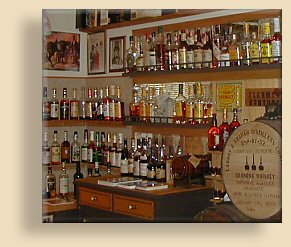 |
|
|
Story and original photography
©1998-99 by John F. Lipman. All rights reserved. |
|
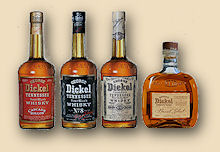
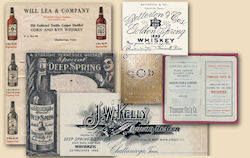
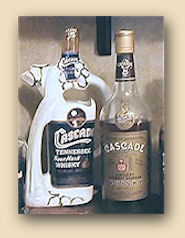 Dickel was a Nashville merchant
who, like many merchants, sold clothing, shoes, housewares, groceries, and
liquor. Merchants who sold their own brand of spirits usually obtained them from whatever vendors they pleased. Dickel was probably no
exception, other than that he eventually narrowed his vendor list down to
just the Cascade Hollow distillery near Normandy. That distillery was
owned by Matthew Sims and McLin Davis, who was the distiller there. The Cascade
Distillery itself was never owned by the George A. Dickel Company, but its whisky was
sold as George A. Dickel's Cascade Whisky. In 1888, Matthew
Sims sold his share to Victor Shwab, who was George Dickel's partner, and
ten years later Sims' heirs sold him the remaining interest, which gave
Victor Shwab complete ownership of the distillery. Shwab was more than
just George Dickel's partner, he was also his brother-in-law. George
Dickel died in 1894, leaving his interest in George A. Dickel & Company to
his widow, Victor's sister-in-law (Augusta, the "A" in "George A. Dickel",
was George's wife as well as it's chief financier; her sister was Emma,
married to Shwab).
Dickel was a Nashville merchant
who, like many merchants, sold clothing, shoes, housewares, groceries, and
liquor. Merchants who sold their own brand of spirits usually obtained them from whatever vendors they pleased. Dickel was probably no
exception, other than that he eventually narrowed his vendor list down to
just the Cascade Hollow distillery near Normandy. That distillery was
owned by Matthew Sims and McLin Davis, who was the distiller there. The Cascade
Distillery itself was never owned by the George A. Dickel Company, but its whisky was
sold as George A. Dickel's Cascade Whisky. In 1888, Matthew
Sims sold his share to Victor Shwab, who was George Dickel's partner, and
ten years later Sims' heirs sold him the remaining interest, which gave
Victor Shwab complete ownership of the distillery. Shwab was more than
just George Dickel's partner, he was also his brother-in-law. George
Dickel died in 1894, leaving his interest in George A. Dickel & Company to
his widow, Victor's sister-in-law (Augusta, the "A" in "George A. Dickel",
was George's wife as well as it's chief financier; her sister was Emma,
married to Shwab).
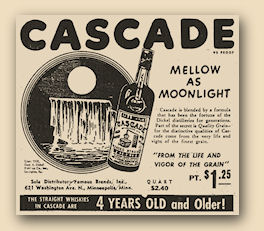 And
when she died in 1916, the entire company, including
the distillery, became the realm of her brother, Victor Shwab. The
George A. Dickel's Cascade Whisky brand was already very well-known,
and Victor did not change the name; otherwise this fine product might have
been known as Shwab's Cascade Whisky.
And
when she died in 1916, the entire company, including
the distillery, became the realm of her brother, Victor Shwab. The
George A. Dickel's Cascade Whisky brand was already very well-known,
and Victor did not change the name; otherwise this fine product might have
been known as Shwab's Cascade Whisky. 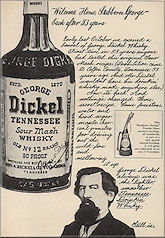 First, he
located the site of the original Cascade Hollow Distillery. Unfortunately,
it would not be possible to rebuild what was once there. So he purchased
the adjacent property, which accessed the same water source, Cascade
Spring, and began construction of a modern facility that he felt would be
capable of producing the
finest Tennessee-style whiskey ever made. That was in 1958. He had a few
things going for him. One of those, of course, was the water. That really
does make a difference. Another was the supposedly-original Shwab recipe
(it would really have been McLin's recipe, but that's just the way whisky
folks are) . It's
competitor over in Lynchburg claims continuity back to Jack Daniel's
original recipe, but there's no evidence of that. In fact, some would say
Jack Daniel's is not very far from Old Forester in its flavor, with the
addition of the smoky maple leaching process. It certainly does not taste much
like George Dickel whisky.
First, he
located the site of the original Cascade Hollow Distillery. Unfortunately,
it would not be possible to rebuild what was once there. So he purchased
the adjacent property, which accessed the same water source, Cascade
Spring, and began construction of a modern facility that he felt would be
capable of producing the
finest Tennessee-style whiskey ever made. That was in 1958. He had a few
things going for him. One of those, of course, was the water. That really
does make a difference. Another was the supposedly-original Shwab recipe
(it would really have been McLin's recipe, but that's just the way whisky
folks are) . It's
competitor over in Lynchburg claims continuity back to Jack Daniel's
original recipe, but there's no evidence of that. In fact, some would say
Jack Daniel's is not very far from Old Forester in its flavor, with the
addition of the smoky maple leaching process. It certainly does not taste much
like George Dickel whisky.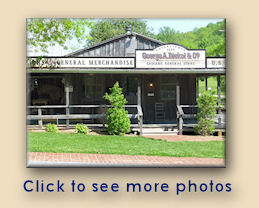

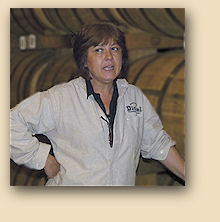 Gina
spends as long as necessary at each stop, and she is happy to answer
as many questions as we have to ask. We couldn’t imagine a more personable
and knowledgeable guide.
Gina
spends as long as necessary at each stop, and she is happy to answer
as many questions as we have to ask. We couldn’t imagine a more personable
and knowledgeable guide.
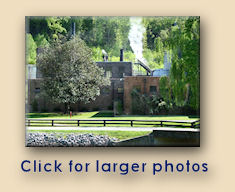
 not
just what the tour guides are trained to know (you might want to remember
that when we get to Jack Daniel later on today).
not
just what the tour guides are trained to know (you might want to remember
that when we get to Jack Daniel later on today). 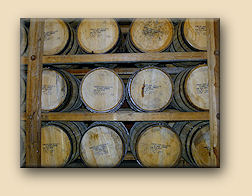 nor
did either of the distillers we met yesterday at Corsair and Tennessee
Distilling (Collier & McKeel) in Nashville.
nor
did either of the distillers we met yesterday at Corsair and Tennessee
Distilling (Collier & McKeel) in Nashville.